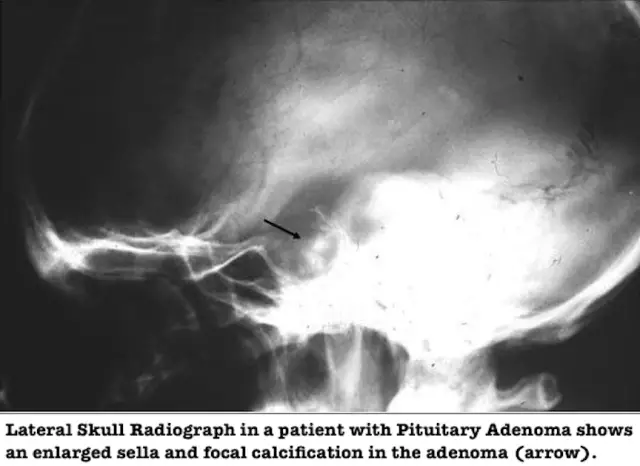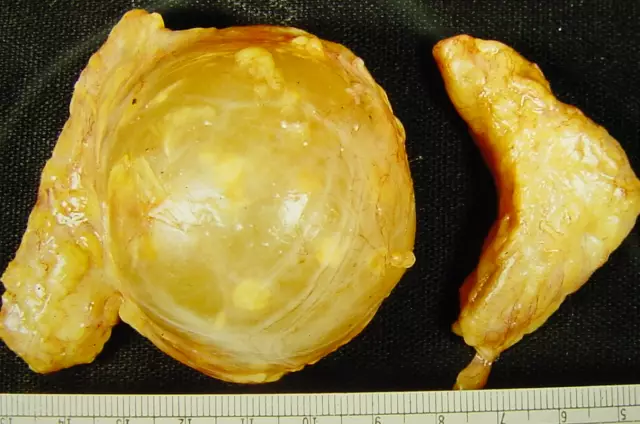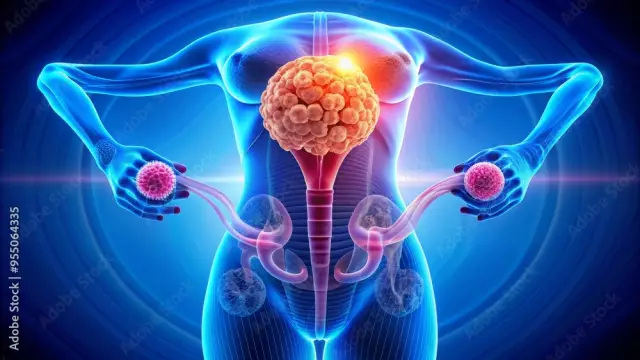- Author Rachel Wainwright [email protected].
- Public 2023-12-15 07:39.
- Last modified 2025-11-02 20:14.
Adrenal glands
The adrenal glands (adrenal, adrenal glands) are paired endocrine glands located above the kidneys.

The structure and function of the adrenal glands
In the structure of the glands, the outer cortical substance and the inner medullary are distinguished. They have different origins, but in the process of historical development they have united into one body. The adrenal glands have different shapes - the right triangular, and the left crescent. Outside, the glands are covered with a capsule that sprouts inward.
The cortical substance predominates, and is about 9/10 of the mass of the glands. It consists of cells that secrete corticosteroid and sex hormones. The cells are located in relation to the blood capillaries so that the secretion immediately enters the bloodstream. In the adrenal cortex, there are three zones that differ in cellular composition:
- Glomerular (produces aldosterone);
- Bundle (produces cortisol, corticosterone);
- Mesh (synthesizes androgens).
The role of corticosteroid hormones in the body is difficult to overestimate. They are involved in key points in the regulation of metabolism (proteins, fats, carbohydrates, water and salts), energy, in the body's immune defense, regulation of vascular tone, adaptation to stress.
The medulla in the center of the adrenal gland is not sharply demarcated from the cortical, and consists of chromaffin cells, as well as many nerve fibers and cells. Secretory chromaffin cells synthesize adrenaline, dopamine and norepinephrine. According to their chemical structure, they belong to the group of catecholamines, and are initially formed from the amino acid tyrosine. The release of catecholamines into the blood is stimulated by various stimuli - emotions, hypoglycemia, hypothermia, physical work, etc.
Adrenaline increases blood glucose levels due to the breakdown of glycogen, enhances the breakdown of fats with the release of energy, increases blood pressure, increases the frequency and strength of heart contractions, relaxes smooth muscles in the walls of the bronchi, and enhances heat generation in the body.
Norepinephrine, the precursor of adrenaline, has slightly different effects - it slows down heart contractions, dilates the arteries that supply the heart with blood, and increases diastolic pressure.
Study of adrenal function
It is impossible to feel the adrenal glands during palpation. Ultrasound examination allows them to be visualized and measured.
Their function is studied by examining the level of hormones and their metabolites in the blood. So, to assess the glucocorticoid function of the adrenal glands, the level of 11-oxycorticosteroids is determined in the blood, and free cortisol in the urine.
Functional tests allow you to assess the response of the adrenal glands to external stimulation. Most often, a test with dexamethasone is used, which helps to differentiate an adrenal tumor from hyperplasia associated with excessive synthesis of ACTH in the pituitary gland. A test with ACTH allows you to identify functional adrenal insufficiency, but due to the potential health hazard, such tests should be carried out in a hospital.
Mineralocorticoid function of the adrenal glands and the formation of the hormone aldosterone can be assessed by the content of potassium and sodium ions in the blood serum. With adrenal insufficiency, the sodium content is significantly reduced, and potassium is increased, with excessive formation of aldosterone, potassium, on the contrary, will be less, and sodium more.
X-ray methods for examining the adrenal glands - computed and magnetic resonance imaging, angiography. They allow you to identify adrenal tumors, assess the size and structure of the glands.
Diseases and approaches to treatment of the adrenal glands
All diseases of the adrenal glands can be divided into two large groups - one of them is manifested by excessive function of the adrenal glands, and the second, on the contrary, reduced.
A decrease in the work of the glands occurs when the adrenal glands are removed, they are damaged by tuberculosis, amyloidosis, sarcoidosis, with hemorrhage in the adrenal glands, or with a decrease in the formation of ACTH in the pituitary gland. Treatment of the adrenal glands in this case requires replacement therapy with those hormones, the lack of which has formed, as well as elimination of the cause of hypofunction.
Excessive production of hormones occurs with hyperplasia from excessive stimulation of ACTH (for example, with a pituitary tumor) or with an adrenal tumor. Tumors from the cortical substance - corticosteromas - are often mixed, with them there is an excessive formation of all hormones of the adrenal cortex. If a tumor originates from cells that form androgens, it is called an androsteroma. Its manifestation will be viril syndrome. If cells that form aldosterone have undergone tumor transformation, then an aldosteroma is formed, and its manifestation will be pronounced disorders of the exchange of water and salts.
In Itsenko-Cushing's disease, the sensitivity of the hypothalamus to the inhibitory effect of cortisol is impaired, as a result of which the adrenal glands produce it intensively and hypertrophy. In such patients, carbohydrate metabolism is disturbed, sexual function is reduced. The appearance is characteristic - fat deposits in the abdomen, trunk and neck, red-violet stretch marks on the skin - striae, moon-shaped face, excessive hair growth. Treatment for Itsenko-Cushing's syndrome consists of removing the adrenal glands and lifelong hormone replacement therapy.
With a benign degeneration of the cells of the adrenal medulla, the course of the tumor is asymptomatic, and it often becomes an accidental finding during examination. Malignant hormone-active tumors are manifested by symptoms of hormone overproduction, hormone-inactive tumors are accompanied by general intoxication and an enlarged abdomen.
Treatment of the adrenal glands for tumor lesions is surgical, for malignant tumors, chemotherapy should be accompanied. After removal of the adrenal glands, lifelong hormone replacement therapy is required.
Children have congenital adrenal cortex dysfunction, Itsenko-Cushing's disease, hypoaldosteronism, chromaffinoma, Addison's disease. Quite often, they have hemorrhage in the adrenal glands, for example, with severe birth trauma, serious infections (meningococcal meningitis, etc.).
Found a mistake in the text? Select it and press Ctrl + Enter.






